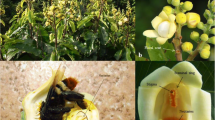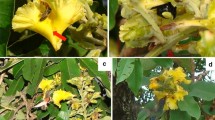Summary
The nectar production of Epilobium angustifolium L. was investigated at 20°C and 50%, 78% and 94% ambient humidity in the climatic test chamber. By means of permanent pipettes, freshly produced nectar was sucked off immediately after secretion, and nectar samples were also taken at 10-h and 48-h intervals to investigate the postsecretory influence of ambient humidity. Volume and sugar concentration of samples from individual flowers were measured and the sugar contained was calculated. The rate of sugar production remains constant for all ambient humidities and extraction intervals investigated; the mean value for all 180 samples is 1.55 mg sucrose equivalents/24h. Sugar concentration of secretion nectar is linearly dependent on ambient humidity over the range investigated, and nectar volume and sugar concentration change according to the theoretically expected curve for solutions with a sugar content of 1.55 mg sucrose. The response of secretion nectar to steplike changes in ambient humidity was investigated and the transient function described. The nectaries respond immediately to changes in ambient humidity. The consequences of the results for nectar production and nectar reward of individual flowers in the field and for the optimal foraging of pollinators are discussed. Discussion concentrates particularly on the following questions: what influence the variability of nectar reward in individual flowers may have on flower-visiting bumble-bees; whether these animals have the sensory capabilities to measure sugar exactly; and whether the water relations of pollinators may also influence foraging behaviour.
Similar content being viewed by others
References
Betts A (1929) Das Aufnahmevermögen der Bienen beim Zuckerwasserfüttern. Arch Bienenk 10:301–309
Benham BR (1969) Insect visitors to Chamaenerion angustifolium and their behaviour in relation to pollination. The Entomologist 102:221–228
Beutler R (1936) Wie stellt man den Wert einer Pflanze als Nektarspender fest? Deutscher Imkerführer 10:104–110
Beutler R (1953) Nectar Bee World 34:106–116, 128–136, 156–162
Boetius J (1948) Über den Verlauf der Nektarabsonderung einiger Blütenpflanzen. Beih Schweiz Bienenzeitung 2:257–317
Bonnier G (1878) Les nectaires. Etude critique, anatomique et physiologique. Ann Sci Nat Ser Bot 8:5–212
Calder WA (1979) On the temperature-dependency of optimal nectar concentrations for birds. J Theor Biol 78:185–196
Caraco T (1980) On foraging time allocation in a stochastic, environment. Ecology 61:119–128
Corbet SA, Willmer PG, Beament JWL, Unwin DM, Prŷs-Jones OE (1979a) Post-secretory determinants of sugar concentration in nectar. Plant Cell and Environment 2:293–308
Corbet SA, Unwin DM, Prŷs-Jones OE (1979b) Humidity, nectar and insect visits with special reference to Crataegus, Tilia and Echium. Ecol Entomol 4:9–22
Fasman GD (1976) CRC Handbook of Biochemistry and Molecular Biology. Vol I. Physical and chemical data. CRC Press
Frisch K von (1934) Über den Geschmackssinn der Biene. Ein Beitrag zur vergleichenden Physiologie des Geschmacks. Z Vergl Physiol 21:1–156
Frisch K von (1965) Tanzsprache und Orientierung der Bienen. Springer, Berlin Göttingen Heidelberg
Grigorenko WN (1975) Nektaroproduktiwnost Chamaenerion angustifolium (L.) SCOP. w nekotorich raionach krassnojarskowo kraja. Rast Resurcy 11:34–42
Haupt H (1902) Zur Sekretionsmechanik extrafloraler Nektarien. Flora (Jena) 90:1–41
Heinrich B (1972) Energetics of temperature regulation and foraging in a bumblebee. J Comp Physiol 77:49–64
Heinrich B (1976) Resource partitioning among some eusocial insects: bumblebees. Ecology 57:874–899
Heinrich B (1979) Bumblebee economics. Harvard University Press Cambridge and London
Hocking B (1953) The intrinsic range and speed of flight of insects. Trans Roy Ent Soc London 104:223–345
Huber H (1956) Die Abhängigkeit der Nektarsekretion von Temperatur, Luft- und Bodenfeuchtigkeit. Planta 48:47–98
Inouye DW, Favre ND, Lanum JA, Levine DM, Meyers JB, Roberts MS, Tsao FC, Wang YY (1980) The effects of nonsugar nectar constituents on estimates of nectar energy content. Ecology 61:992–996
Jamieson CA, Austin GH (1958) Preference of honeybees for sugar solutions. X. Int Congress Entomol Montreal 1956 Vol 4:1059–1062
Käpylä M (1978) Amount and type of nectar sugar in some wild flowers in Finland. Ann Bot Fen 15:85–88
Kleber E (1935) Hat das Zeitgedächtnis der Bienen biologische Bedeutung? Z Vergl Physiol 22:221–262
Knuth P (1898) Handbuch der Blütenbiologie. Engelmann, Leipzig
Landolt-Börnstein (1977) Zahlenwerte und Funktionen aus Naturwissenschaft und Technik. Neue Serie Hellwege KH (ed) Vol IV/1b Dichten flüssiger Systeme. Springer Berlin Heidelberg New York
Mikhailova EA (1959) Nekotorie dannie o nektarnosti kipreja w uslowijach Tomskoi oblasti. Izvest Tomsk Otd Bot Obshch 4:109–112
Mosquin T (1966) A new taxonomy for Epilobium angustifolium L. Brittonia 18:167–188
Nunez JA (1966) Quantitative Beziehungen zwischen den Eigenschaften von Futterquellen und dem Verhalten von Sammelbienen. Z Vergj Physiol 28:197–210
Oertel E (1946) Effect of temperature and relative humidity on sugar concentration of nectar. J Econ Entomol 39:513–515
Park OW (1929) The influence of humidity upon sugar concentration in the nectar of various plants. J Econ Entomol 22:534–544
Percival MS (1961) Types of nectar in angiosperms. New Phytol 60:235–281
Pflumm W (1969) Beziehungen zwischen Putzverhalten und Sammelbereitschaft bei der Honigbiene. Z Vergl Physiol 64:1–36
Pflumm W (1975) Einfluss verschiedener Zuckerwasser-Konzentrationen und der Anwesenheit der Artgenossen auf das Sammelverhalten von Wespen (Hymenoptera: Vespidae). Entomol Germanica 2:7–21
Pouvreau A (1974) Le comportement alimentaire des bourdons (Hymenoptera, Apoidea, Bombus Latr.): La consommation de solutions sucrées. Apidol 5:247–270
Pyke GH, Pulliam HR, Charnov EL (1977) Optimal foraging: a selective review of theory and tests. Q Rev Biol 52:137–154
Real L (1980) Fitness, uncertainty and the role of diversification in evolution and behavior. Amer Nat 115:623–638
Real L (1981) Uncertainty and pollinator-plant interactions: the foraging behavior of bees and wasps on artificial flowers. Ecology 62:20–26
Real L, Ott J, Silverfine E (1982) On the tradeoff between the mean and the variance in foraging: effect of spatial distribution and color preference. Ecology 63:1617–1623
Scullen HA (1940) Relative humidity and nectar concentration in Fireweed. J Econ Entomol 33:870–871
Sotavalta O, Lajasmo L, Tapana M, Tuomisto J (1962) On the preference shown by insects for certain food-sugar solution concentration in feeding. Ann Acad Sci Fenn Ser A IV Biol 1–40
Southwick EE, Loper GM, Sadwick SE (1981) Nectar production, composition, energetics and pollinator attractiveness in spring flowers of western New York. Am J Bot 68:994–1002
Stephens DW, Charnov EL (1982) Optimal foraging: some simple stochastic models. Behav Ecol Sociobiol 10:251–263
Vansell GH (1940) Nectar secretion in Poinsettia blossoms. J Econ Ent 33:409–410
Waddington KD, Allen T, Heinrich B (1981) Floral preferences of bumblebees (Bombus edwardsii) in relation to variable vs. fixed rewards. Animal Behaviour 29:779–784
Waddington GD (1972) Evaluating responses of honey bees to sugar solutions using artificial flower feeder. Ann Ent Soc Am 65:857–862
Author information
Authors and Affiliations
Additional information
Respectfully dedicated to Dr. H.A. von Stosch, the gentleman, on the occasion of his 75th birthday
Rights and permissions
About this article
Cite this article
Bertsch, A. Nectar production of Epilobium angustifolium L. at different air humidities; nectar sugar in individual flowers and the optimal foraging theory. Oecologia 59, 40–48 (1983). https://doi.org/10.1007/BF00388069
Received:
Published:
Issue Date:
DOI: https://doi.org/10.1007/BF00388069




